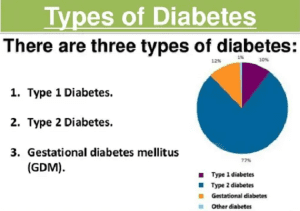Symptoms Of Diabetes: Diabetes is a physical condition that lasts a lifetime and causes more than one million deaths worldwide each year. In addition, anyone can be affected by diabetes.
Diabetes occurs when the body fails to break down all the blood sugar (glucose). This complication can lead to heart attack and stroke. Diabetes can also lead to blindness, kidney damage, and sometimes amputation.

This problem is increasing all over the world. At present, the number of people suffering from diabetes is more than 420 million. That’s four times more than 30 years ago, according to the World Health Organization.
Doctors say that despite having such a high risk of diabetes, more than half of the people affected by the disease are not aware of the disease. However, in some cases, it is possible to prevent diabetes by following certain rules and regulations in life.
What is Diabetes and What Causes Diabetes?
When we eat food, our body breaks down the sugar from that food into sugar (glucose). The hormone insulin, which is secreted from the pancreas, directs the cells in our body to absorb sugar. This sugar acts as fuel or energy for the body.
Diabetes occurs when the body cannot make insulin or it does not work properly. And as a result, sugar starts to accumulate in the blood.
Also Read – How to Increase immunity or Immune system In our Body, Natural Way to Increase Immunity
Types of Diabetes
There are two types of diabetes, type one diabetes, and type two diabetes.

Type 1 diabetes:
In type 1 diabetes, the production of insulin from the pancreas stops. Then glucose begins to accumulate in the bloodstream.
Scientists have not yet been able to figure out what caused this. However, they believe that there may be genetic factors behind it. Or a viral infection in the pancreas may cause damage to the insulin-producing cells. About 10 percent of people with diabetes have type 1 diabetes.
Type 2 Diabetes:
People with this type of diabetes do not produce enough insulin in their pancreas or this hormone does not work properly. Usually, middle-aged or elderly people develop type 2 diabetes. People who are overweight and have to sit and work most of the time despite being younger are also more likely to have this type of diabetes.
People in certain areas are also at risk for diabetes. It includes South Asia.
Many women can get diabetes even if they have children. They can develop diabetes when their bodies do not produce enough insulin for themselves and their children.
One study found that 6 to 17 percent of pregnant women may have diabetes. Keeping their body sugar levels under control through diet, exercise or insulin can help them avoid the risk of developing type 2 diabetes.
What Are the Symptoms of Diabetes?
The most common diabetes symptoms include:
- Found very thirsty,
- Frequent urination than usual, especially at night.
- Feeling tired
- Weight loss for no apparent reason
- Frequent infections with inflammatory diseases
- Blurred vision
- If it is cut anywhere on the body, it is too late to dry it
Frequent urination and thirst:
Frequent urination is one of the symptoms of diabetes. When the amount of sugar in the blood increases, the kidneys want to excrete it through urine.
This results in frequent urination. At this time the thirst for water also increases. Frequent urination increases the body’s need for water, so thirst also increases.
Increased Appetite:

When the level of insulin in the body decreases, the body cannot retain sugar. The body needs sugars to provide energy.
When there is a lack of sugar, the body loses energy. As a result, the demand for calories increases, and appetite increases.
Feeling tired and exhausted:
As the appetite increases, the body becomes weak, tired, and exhausted. Since the body cannot maintain sugar balance at this time, these problems occur.
Excessive weight loss:
Another notable symptom of diabetes is excessive weight loss. Excess blood sugar at this time is one of the reasons for weight loss. Weight loss of about 10 to 20 pounds in two to three months. Therefore, in case of excessive weight loss, it is important to consult a doctor.
Numbness:
Excess blood sugar weakens the nerves so the person may feel numb. Not only that, when the nerves are weak, the blood pressure also goes down. As a result, you may feel dizzy and weak.
Blurred vision:
Elevated blood sugar can affect the eyes. If the eyeball is swollen and changes shape, sudden blinking of the eyes can be a problem.
Decreased immunity:
Diabetes lowers the body’s immune system. This happens due to the increase in the amount of sugar in the blood. As a result, no disease can be cured easily.
Frequent infections:
Blood sugar imbalances can often lead to different types of infections. Decreased immunity also increases the risk of infection.
Dry, rough, and itchy skin:
Our body contains 50 to 6 percent water. Frequent urination and sweating make the body dry. This has an effect on the skin. So at this time, the skin may feel dry, rough, and itchy.
Slow Healing:
If any part of the body is cut or scattered, it is not dry and it takes a long time to dry is also an important sign of rising sugar levels in the body.
If all these symptoms are seen, blood tests should be done as soon as possible without neglecting the advice of the doctor.
Annoyance:
Decreased energy in the body and increased appetite can lead to feeling bad and annoyed all the time. Since the body does not get energy and is not functional, it can make your mood irritable.
If any of these symptoms appear in your body, consult a doctor and check your blood sugar level to find out if you have diabetes.
Doctors say that the symptoms of type 1 diabetes can start in childhood and become more complicated with age.
The risk of type 2 diabetes increases after the age of 40. However, people in South Asia have been at risk since they were 25 years old.
Parents, siblings with diabetes, or those who are overweight, people from any South Asian country, Afro-Caribbean, or black African are also at higher risk.
How to Prevent Diabetes:
Although diabetes is genetic and depends on your lifestyle, you can still control your blood sugar levels if you try. That’s why you need to be particularly aware of food intake and you need to be a very active person.
Processed foods and drinks should be avoided. Instead of white flour bread, you should eat bran flour bread. This is the first step. White pasta, pastries, fizzy drinks, sugary drinks, sweets, etc. should be avoided.
And healthy foods include vegetables, fruits, beans, and whole grains. It is also good to eat healthy oils and nuts. Fish that have omega-three oils should be eaten more. Such as sardines, salmon, and mackerel.
One day you need to eat little by little without breaking your stomach. It is possible to keep blood sugar levels low by exercising.
Doctors say you need to exercise for two and a half hours every week. It also includes brisk walking and climbing stairs.
Weight loss will be followed by fatigue and constant tiredness. If you want to lose weight, you have to do it slowly. From 0.5 kg to 1 kg per week.
It is also important to avoid smoking. Cholesterol levels should be monitored. High levels increase the risk of heart disease.
What Kind of Complications Can Occur Due to Diabetes?
High blood sugar can cause serious damage to blood vessels. If the blood does not flow properly in the body, if the blood does not reach the places where it is needed, then the risk of nerve damage increases. As a result, people may lose their eyesight. Infections can occur in the legs.
Diabetes is a major cause behind blindness, kidney failure, heart attack, stroke, etc., says the World Health Organization.
How Many People Have Diabetes?
According to the World Health Organization, the number of people with diabetes in 1980 was about 11 million. In 2014, it increased to more than 42 crores.
In 1980, the rate of diabetes among people over the age of 18 was less than 5 percent, but in 2014, their number has increased by 6 decades and 5 percent.
The International Diabetes Federation says about 70 percent of adults with diabetes are from middle- and low-income countries, where their eating habits are changing rapidly. The agency says that in 2017, about 1.7 million people died due to diabetes.

